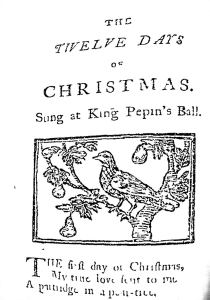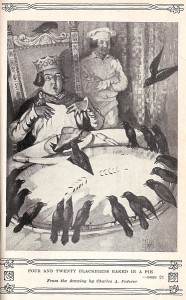There are nine shopping days left before Christmas Day, UNLESS you subscribe to the ancient custom of celebrating Christmas for twelve days instead of one. That gives you until January 5 to complete your gifting A total of twenty-one days. Of course, everyone expects their presents on December 25th, but if you run late, explain that you’re a traditionalist and observe the ancient festival calendar.
At this moment of potential panic, it seems appropriate to go over the ultimate gift giving guide contained in the 12 Days of Christmas, a nursery rhyme that first appeared in 1780 and was set to music in 1909.
There are plenty of theories about what the song means – is it a secret Catholic catechism, a memory device, or a wedding feast? I’m going to go with the wedding feast theory, and will intertwine possible explanations among those famous lyrics (repetitious phrases omitted.)

THE 12 DAYS OF CHRISTMAS
On the first day of Christmas, my true love sent to me
“My True Love” – sounds like the Bride or Bridegroom
A Partridge in a Pear Tree
If you look at it a certain way, a pear is shaped like a heart. Sort of.
Partridge has long been considered an aphrodisiac. Henry IV of France fed partridge to his mistress, Gabrielle d’Estrees. In fact, Henry was so convinced the meal led to better amorous adventures, his chef always kept partridges in the larder. The male partridge is a lusty suitor and very fertile.
On the second day of Christmas, my true love sent to me:
Two Turtle Doves
Turtle doves, a species of pigeon, were considered signs of eternal love.
On the third day of Christmas, my true love sent to me:
Three French Hens
Hens symbolized motherly devotion.

On the fourth day of Christmas, my true love sent to me:
Four Calling Birds
Originally the word “calling” could have originally been “colly” which means black as soot. This indicates the birds were black birds. It was a popular medieval joke to put live black birds under a pie crust so they would fly out when the pie was cut. Sounds good. How, exactly, does one get the birds to stand under the crust without breaking through? I have no idea. But, it would be good entertainment.
On the fifth day of Christmas, my true love sent to me:
Five Golden Rings
When we think “golden rings,” we think about jewelry. But, “golden rings” is also an old term for goldfinches, a type of pheasant. Only the very rich could eat pheasant, and its place on the menu was the high point of any feast.
On the sixth day of Christmas, my true love sent to me:
Six Geese a-Laying
Geese laying eggs are perceived as fertile. Thus, the gift represents good wishes for a “productive” marriage.

On the seventh day of Christmas, my true love sent to me:
Seven Swans a-Swimming
Swan was once a popular dish for the upper classes. The feathers and head were carefully reattached for serving. But since 1482 English swans have been the exclusive property of the reigning monarch, and until the 1990s killing or injuring a swan was an act of treason. If you decide to serve seven swans at your holiday banquet, it will cost you $7000.

On the eighth day of Christmas, my true love sent to me:
Eight Maids a-Milking
When a maid went “a-milking” she had received either a marriage proposal or an invitation for intimacy.
On the ninth day of Christmas, my true love sent to me:
Nine Ladies Dancing
Finally, a chance to push away from the dinner table. Dancing frequently leads to flirting. Perhaps the bridal couple wanted to encourage further wedding celebrations.
On the tenth day of Christmas, my true love sent to me:
Ten Lords a-Leaping
Leaping dances were men only, and are assumed to mean Morris dancers.
On the eleventh day of Christmas, my true love sent to me:
Eleven Pipers Piping
Pipers often accompanied dancing.

On the twelfth day of Christmas, my true love sent to me:
12 Drummers Drumming
Drums were used to announce the arrival of the next course at these banquets, or to maintain the rhythm for dancers.
I conclude that the traditional twelve day Christmas celebration could easily encompass a wedding celebration. By the way, if you ate all of the birds on offer in one day (normal portion size), you would ingest 2384 calories. However, not only is this fewer calories than the average Thanksgiving dinner, which counts for 4500 calories, it is highly likely that in the middle ages those calories would be expended simply trying to keep warm. In 1780 the winter nights were long, dark, and cold. No wonder those who could afford it held amazing parties to while away the time.
Acknowledgements:
Featured Image: Photo of Christmas Tree taken by Author at the Fairmont Orchid Resort
The Twelve Days of Christmas was first published as a nursery rhyme in Mirth Without Mischief in 1780. Frederic Austin set the words to the present melody.
Twelve Days of Christmas. Brownielocks and the Three Bears. Here.
Twelve Things You Might Not Know about the Twelve Days of Christmas. Mentalfloss.com. Here.
Olga Khazan. “Health Consequences of Actually Living the 12 Days of Christmas.” The Atlantic. Dec. 13, 2013. Here.
Nick Stephens. “Red Wine & Famous Aphrodisiacs.” Nick’s Blog. Mar. 26, 2009. Here.
Oliver Thring. “Aphrodisiacs: The Food of Love?” The Guardian. Feb. 11, 2011. Here.
Schüler Velasco. “Twelve Days of Christmas Gifts Costs $116,000.” Christian Science Monitor. Dec. 1, 2014. Here.

Sandra Wagner-Wright holds the doctoral degree in history and taught women’s and global history at the University of Hawai`i. Sandra travels for her research, most recently to Salem, Massachusetts, the setting of her new Salem Stories series. She also enjoys traveling for new experiences. Recent trips include Antarctica and a river cruise on the Rhine from Amsterdam to Basel.
Sandra particularly likes writing about strong women who make a difference. She lives in Hilo, Hawai`i with her family and writes a blog relating to history, travel, and the idiosyncrasies of life.

